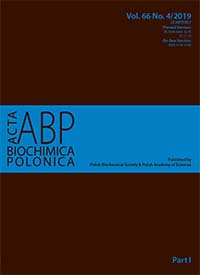Conformational flexibility and ligand binding properties of ovine β-lactoglobulin
Abstract
Ovine β‑lactoglobulin was characterized by spectroscopic (CD), calorimetric (ITC) and X-ray structural studies. The structure of ovine β‑lactoglobulin complex with decanol showed that tight packing of molecules in the crystalline phase enforces a distortion of protein flexible loops resulting in the formation of an asymmetric dimer. The loops surrounding β-barrel in ovine lactoglobulin possessed the same conformational flexibility as observed previously in other lactoglobulins and the change of their conformation regulates the access to the binding pocket. The structure of asymmetric dimer revealed a new region in β-barrel where ligand polar group can be located. These findings indicated protein adaptability to ligand dimensions and inter- and intramolecular interactions in the crystalline phase. Calorimetric and crystallographic studies provided the experimental evidence that ovine lactoglobulin is able to bind aliphatic ligands. Thermodynamic parameters of sodium dodecyl sulfate binding determined by ITC at pH 7.5 had Ka, ΔH, TΔS and ΔG values similar to those observed for bovine and caprine protein indicating the same mechanism of ligand binding.
Acta Biochimica Polonica is an OpenAccess quarterly and publishes four issues a year. All contents are distributed under the Creative Commons Attribution-ShareAlike 4.0 International (CC BY 4.0) license. Everybody may use the content following terms: Attribution — You must give appropriate credit, provide a link to the license, and indicate if changes were made. You may do so in any reasonable manner, but not in any way that suggests the licensor endorses you or your use.
Copyright for all published papers © stays with the authors.
Copyright for the journal: © Polish Biochemical Society.


